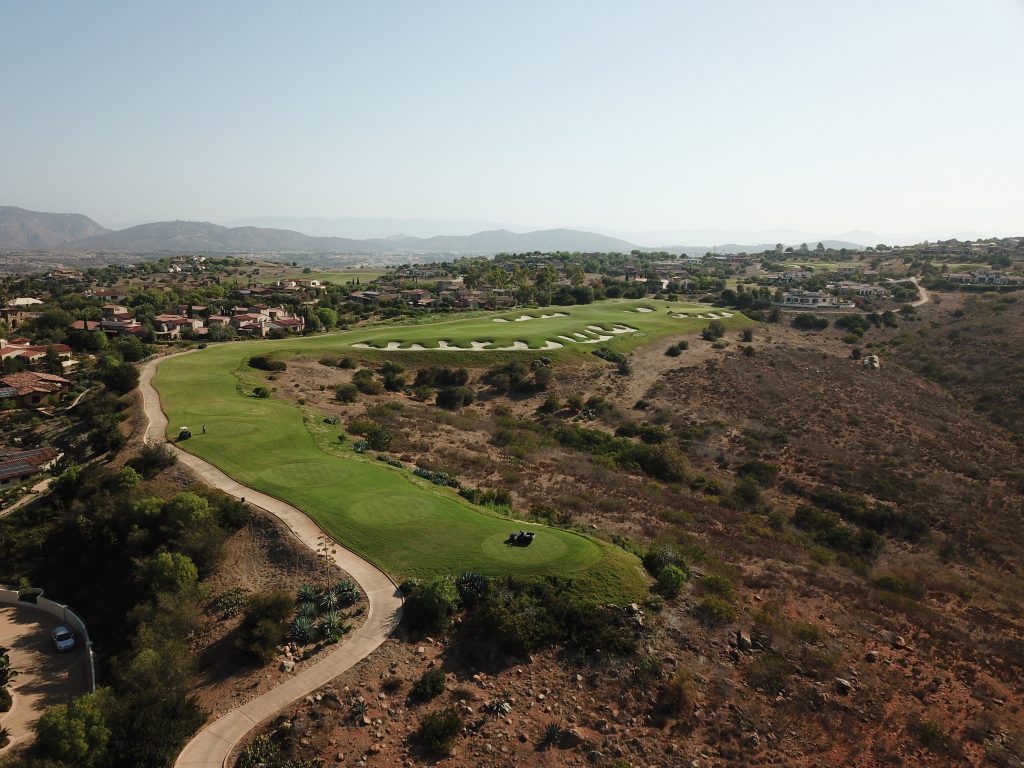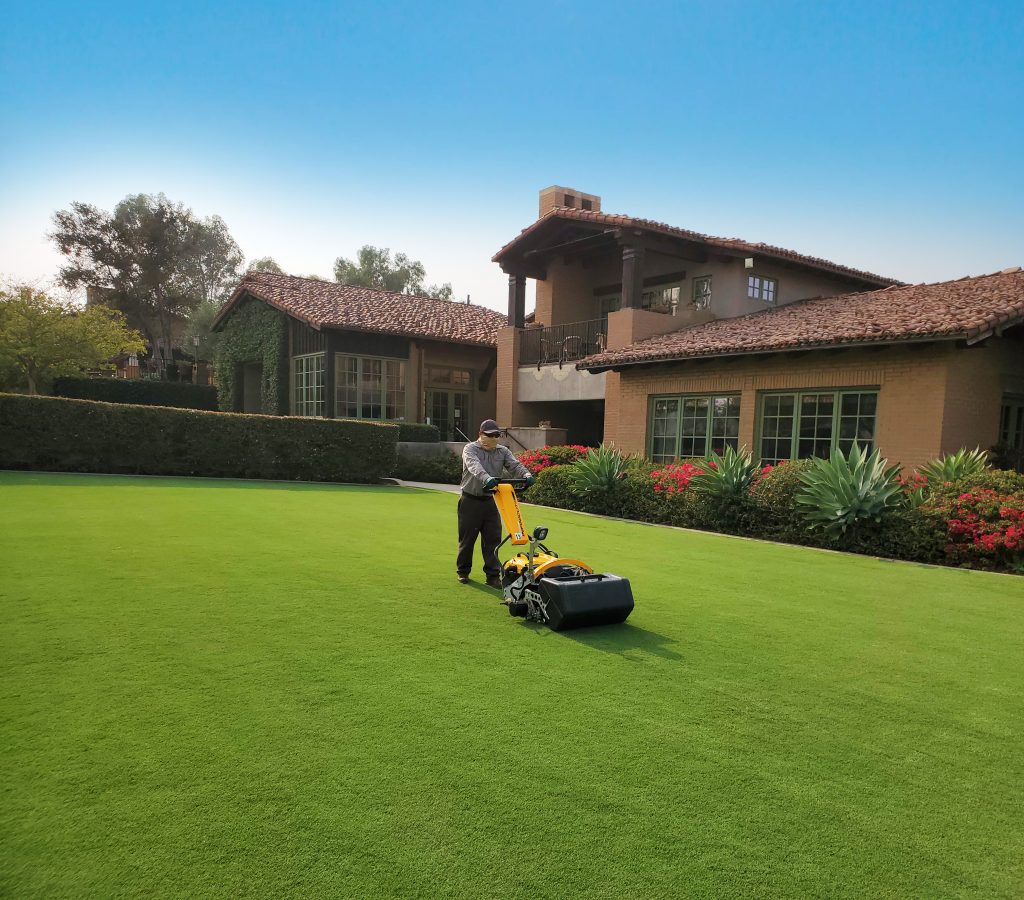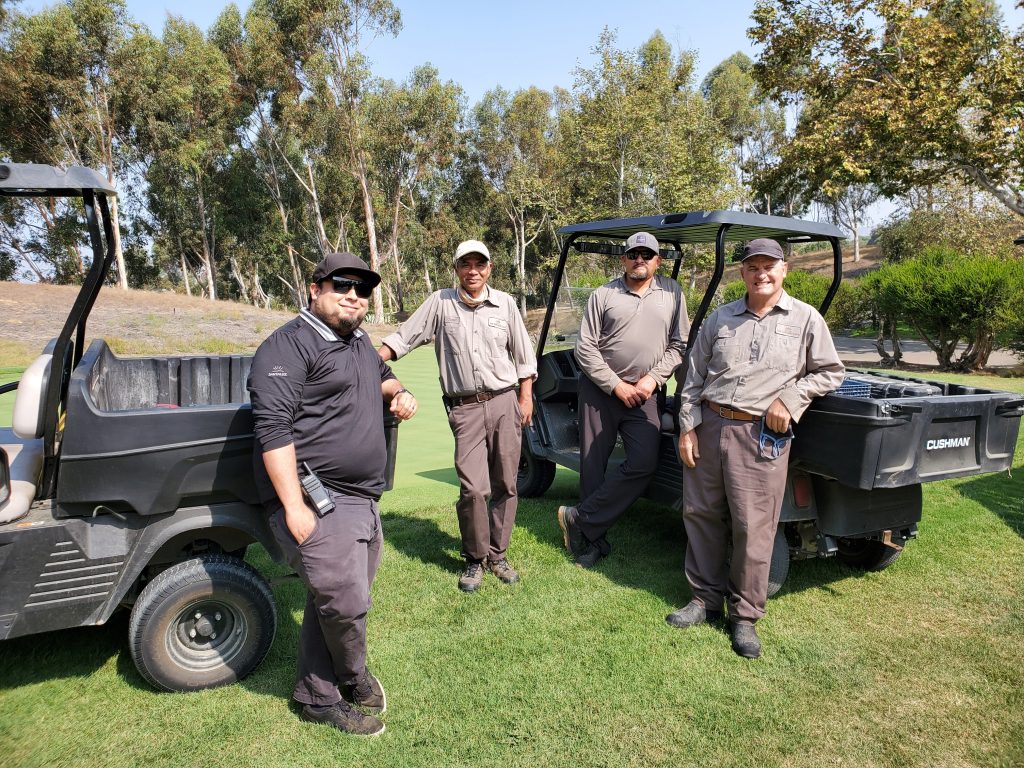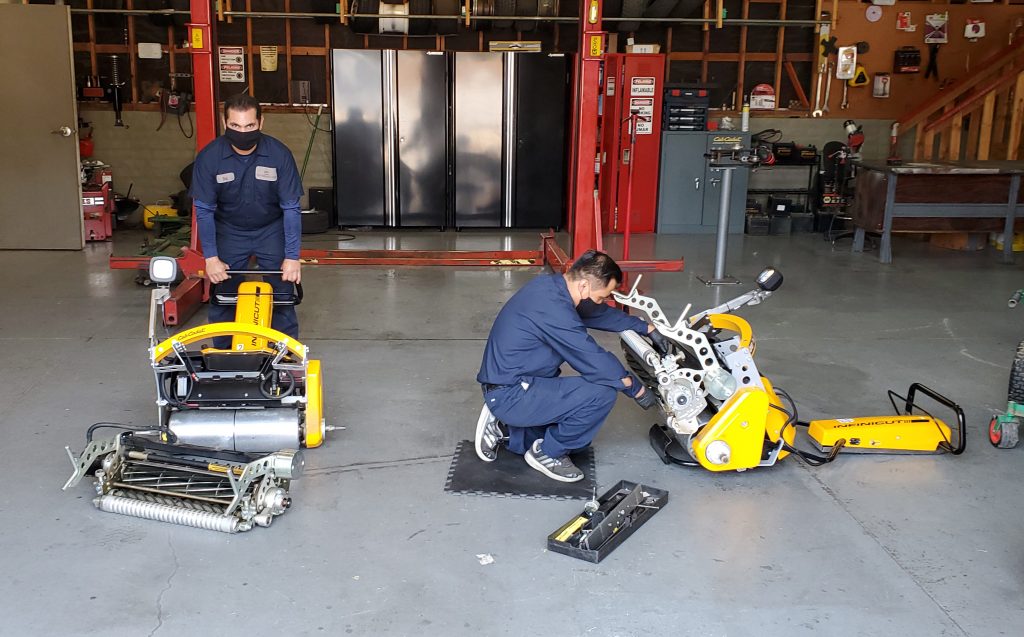Meet the golf course superintendent: Jeff Miller
Related Articles
Jeff is the superintendent at The Santaluz Club, a leading venue in California. He talks about the soil condition of a course in a mountainous area, why he’s a fan of lithium batteries for some course machinery and how the club recycles water for irrigation purposes.
The Santaluz Club in San Diego is one of the finest golf resorts in California. At its heart is the Rees Jones-designed, 300-acre Santaluz Golf Course, a championship course crafted in accordance with the contours of the land and designed to blend challenge with beauty ‘in a setting unlike any other’.
Filled with scenic vistas and panoramic views, the course is framed by native southern California grasslands. Manicured fairways and bent grass greens chase the naturally forgiving contours of the land, conspiring to produce an unrivaled golf experience that can be enjoyed by players of all skill levels.
We caught up with the venue’s Class A superintendent, Jeff Miller GCSAA, to find out about him and the work that goes into maintaining this stunning facility.

Hi Jeff. Can you give a brief description of your background and how you ended up as a GCSAA Class A superintendent at The Santaluz Club?
I started in the golf Industry at the bottom level in the early 90s just out of high school. Bob Steele, a family friend who was a superintendent, had offered me a job. I had no idea this job would become a career path and shape the rest of my life. I worked in every position for at least a year at different level courses. I was an irrigator, spray tech, operator, assistant mechanic, cart mechanic, foreman and an assistant super. I learned hands on throughout those years. I also worked for many different superintendents and learned from each of them. I found there were many ways to get to the same results. I then studied at Cal Poly Pomona (Los Angeles, California) to acquire a bachelors of science in ornamental horticulture while continuing to work at local courses part time. I believe going to college after having worked made what I was learning much easier. I have been at The Santaluz Club for 19 and a half years. The first 13 years were spent as the first assistant super working under Jim Timke. It was having a strong mechanical background that helped me get the job at The Santaluz Club.
What is the size of your team?
We staff 40 full-time employees. We cross train as much as possible to give us flexibility, but it is a combination of those that work specific tasks and some that we rotate. It is important that you find out what the employee’s capabilities are and manage them. Some of our key employees are:
- First assistant – Tommy Caranci
- Second assistant – Cesar Pena
- Landscape manager – Gus Galvin
- Head mechanic – Sal Soto
- Foreman – Ines Mendoza / Jim Timke (yes, he works for me now!)
- Lead irrigator – Sergio Crescencio
- Administration – Ruby Mendoza.

The course is located on mountainous terrain, is framed by an award-winning native landscape and offers stunning panoramic vistas of the southern California landscape, including glimpses of the Pacific Ocean. What challenges does this present to you and the team in terms of seasonal daily maintenance?
The major challenge is the soil condition. Because the course was ‘carved out’ we have many areas where the soil structure is not consistent due to the ‘cut’ or ‘fill’ during shaping. It is mostly a heavy clay soil. Irrigation must be monitored closely every day because of this inconsistency with infiltration and percolation. We are continually targeting poor draining areas with aerification.
How would you describe your management and communication style toward the team, management and the members, and what level of importance do you attach to this element of your job function?
Communication is extremely important – at every level. We give as much information to our team as possible. The majority of our crew are Hispanic and Spanish speaking which makes it a bit more challenging. We instruct them what to do, but we also tell them why and what the issue will be if it isn’t completed correctly. We definitely keep an open mind when employees have ideas on how to complete their tasks better and more efficiently. It shows we are listening and that they are respected.
The same goes for the members and management team. I just have a bit of a communication barrier with our director of golf Andrew Veysey and his Welsh accent! Just kidding ‘mate’!

You’re using a fleet of INFINICUT walk behind mowers at the club. Please can you explain why you prefer this mower over the more traditional walk behind mowers you would normally see on golf courses?
I feel the quality of cut I get from the reel is the best. Workmanship, design and adjustability are what sets these units apart from the rest. The cutting units can also be swapped very easily into different frames. The mower’s settings can also be set quickly and accurately. They also have many attachments to choose from. I love the flexibility it gives me.
How do you use the INFINI APP feature in your maintenance routines and what does this feature enable you to achieve?
This feature is great when setting up the unit’s FOC. It also works great for troubleshooting issues. We will also use it when training employees. The APP will allow you to change mowing speed while the machine is operating, which is very helpful if a new employee is having a hard time with the speed. Making adjustments on the fly is a time saver! The APP also allows me to monitor battery levels, confirm mowing settings and any fault codes when driving by.
How important is it to you that the mowers use lithium as their power source and what are the immediate benefits you have experienced?
Having many years of experience with lithium I have found it to be a more consistent power source than lead acid. Lithium’s voltage is more consistent, it weighs less and provides more charge cycles. Less weight on greens is important because compaction can be an issue. In the long run there is less maintenance and a lower cost with lithium batteries.
What has been your experience of working with the INFINICUT team?
It has been great! I love the level of support and dedication to their product. I was expecting more challenges with the distance between us however they have done great to meet my needs.

What height of cut do you use across the course and how often are the different areas mowed?
- Greens (G2 / Pure Select Bentgrass) – .120” six or seven times a week.
- Tees (Tifgreen 328 Hybrid Bermuda) – .325” two to three times a week.
- Collars (Tifgreen 328) – .325” two to three times a week.
- Fairways (Tifway 419) – .625” two to three times a week.
- Roughs (Tifway 419) – 2.25” once a week.
What irrigation system are you running across the course and in what areas and how often do you irrigate and how do you monitor the moisture requirement of the plant?
We run a Rain Bird Cirrus system with two Flowtronics pump stations capable of 3000gpm each. The entire 320 acre property has irrigation installed. The majority of the year we irrigate 160 acres on a daily basis and the remaining is native grasses which are only irrigated when needed for re-establishment. There will be times during the non-growing months we would not have to water for a few weeks if we get rain. To monitor moisture, we have a weather station on the property and our irrigators use the Spectrum technologies TDR 350 to help us make the necessary adjustments in specific areas.
Water conservation is a central element to the overarching values and mission of the master plan for Santaluz which includes reclaimed water for irrigation. How does this initiative work and what results have been achieved in savings?
The use of recycled water along with drought tolerant plant species has not only saved millions of dollars it has conserved millions of gallons of potable water. Although the cost for recycled water is only a third of the price for potable water there are some drawbacks. Recycled water has a lot of salts and a high pH. Over the years, salts have accumulated to the point heavy aerification is needed to correct the damaged soil. Recycled water and poor soil that is difficult to leach is not a good combination. As a solution we have been working on approving a reverse osmosis plant at one of our irrigation lakes.

How do you ensure you achieve healthy and strong plant growth for the best playing surfaces?
To ensure best growing conditions our fertiliser program is based on soil, tissue and water samples taken multiple times of the year. Soil samples taken twice a year. Tissue samples on greens taken on a weekly basis. Water samples are taken at the point connection and from lakes quarterly. We also have a strong fungicide program for the greens and an annual maintenance program that includes verticutting, topdressing and aerification on most parts of the course.
The course has a combination of many small bunkers and some very large and deep bunkers. All are beautifully presented and look super sharp! What maintenance program do you run to achieve such a high standard of presentation?
Our bunker maintenance program is extremely intensive and time consuming. The Reese Jones bunker design didn’t take into consideration the amount of time it would take to maintain. Because of the contours and the depths of the bunkers the majority are all hand mowed and raked. There are really no access points to get equipment in or out for that matter. Over 30 percent of our wage budget is used towards the maintenance of them! Greenside bunkers are raked out daily. Fairway bunkers raked once a week and touched up daily. We ‘flymow’ bunker surrounds on six holes per week. Heavy use of growth regulators are applied every three weeks during the growing season. The wedge white bunker sand is checked for correct depths twice annually and corrected, two inches on faces and four to six inches at the base. We dislike bunkers just as much as the players do!

How often do you topdress the course?
- Greens: Every three weeks during the growing season (March to October).
- Tees: Every May.
- Fairways: Every May the fairways get 400 to 500 tonnes over the 28 acres.
- Roughs: Once per year during growing season in high traffic / problematic areas.
On the electric putting greens rollers, you replaced the lead-acid batteries with lithium-ion batteries to reduce the overall weight of the rollers and integrated a battery management system into the existing controller to protect the lithium pack from damage. What results has this delivered?
The original weight of the lead acid batteries was 500 pounds compared to the 125 pound lithium set we installed. The heavy rollers left ridges if the moisture was even slightly high and steering the machine had much more resistance. The lithium reduced this excessive compaction and stress to the turf. The goal was to lower the noise, keep the weight down and keep oil / gas off the greens. Lithium helps us make that happen and the cost savings was an added benefit. With the help of a local company, Flux Power, we started using lithium back in 2012. I figured we have saved almost $2,000 over the first five years. We are now on the second set of lithium cells and still utilising the BMS system so the savings will be about $5,800 over 10 years.
What aeration program do you run across the course and what is your choice of machinery for this?
- Greens: Hollow tine twice per year (spring / fall) 5/8” quad tine (Toro 648 with the CoreMax48 core collection attachment)
- ¼” Venting greens eight times per year (Toro 648)
- 5/16” solid tine twice per year 8” deep (Weidenmann GXi-6).
- Fairways: 5/8” solid tine twice per year 4” depth (Toro Outcross/1298 combo).
- ½” solid tine six times per year 6” depth compacted areas (Weidemann GXi-6).
- Roughs: 5/8” solid tine once a year in problematic areas mostly where we have cat traffic (Toro Outcross/1298 combo).
The pressures on the superintendent to deliver a better product are growing year on year and the level of professionalism is rising with this. What do you think are the qualities now needed to meet the requirements and demands of members and players by someone in your position and how does this help contribute to the business of golf?
I completely agree. I feel with anything, over time people just expect things to get better. The more things cost the higher the expectation. To meet these expectations you need to be strong in administrative and organisational skills. You should also be able to handle budgets and finances well.

What currently gives you the greatest satisfaction from your job, how do you feel daily when you are moving around the Santaluz course viewing what you and the team have accomplished and what do you feel are your biggest achievements to date?
I think like many, my greatest satisfaction comes from hearing when my own employees and members mention that the course looks or plays great. More often than not, we hear about the problems, so it is definitely great when we hear that positive affirmation.
The two biggest achievements would be acquiring approval from the city of San Diego for a reverse osmosis facility to improve the recycled water quality and the second is being on the forefront of applying robotic technology in the golf industry.
Although I am proud of those accomplishments it is important to realise that many small accomplishments make a big difference. Do all the small things to the best of your ability and the ‘bigger picture’ will be that much greater.
A couple of my favourite small accomplishments for example would be taking the time to pull liners out of the cups (24 of them) and hand glue in a ribbon with about 2,000 crystals per cup for the ladies’ ‘Crystal Cup’ event. The ladies were blown away and super appreciative. I had a few cases of beer in my office the following Monday!
The other was simply painting a 60 foot by 30 foot, Santaluz sunburst logo at the back of the driving range and outlining it with strands of LED lights. It only gets put up for special events a few times a year. It just looks so impressive at the back of the range. I set up a timer and when it turns on at dusk you can hear a small crowd of members give a little cheer!
What are the most memorable things you have been taught in your career and by whom, and with your years of experience, what advice would you give to youngsters starting out and wanting to pursue a career in the profession?
The first one that comes to mind was from Dave Buckles. He told me about the time I was graduating college that in this career your golf course will never be perfect, but you should strive to be proud of it. That still sticks in my mind to this day and kind of keeps it all in perspective. Working for Sandy Clark in my early years I remember him encouraging me to get a college education. Without his direction early on I would definitely not be in the position I am in today. I am very grateful to him being that mentor. I spent the majority of my assistant career here at The Santaluz Club and under Jim Timke. His drive and dedication set a huge example for what it takes to manage at this level. I saw that he received tremendous respect from all his employees due to his hard-working nature, honesty and respect for them. Discipline is what he reminded us of on a daily basis and it was always about not ever waiting to do things.
My advice would be to learn as much as possible. Value what you learn, good and bad. Learn from your mistakes and own them. Get a mentor and don’t be afraid to ask for guidance. You should be knowledgeable in every position that you manage. If you choose to go to college, keep in mind you will not learn everything there. It will teach you what you don’t know, what you still need to learn and how to learn. Learning is lifelong and with experience comes better decisions. Finally, read every superintendent’s answer to this question in the profiles in GreenKeeping magazine!

What changes do you think need to be made to benefit the industry sector and profession of the superintendent?
Overall, the industry needs to focus on efficiency and productivity. Ever increasing cost with water, electricity, wages and materials costs are making it difficult for courses to operate or forcing them to close down. The more we use the resources we have wisely the more sustainable we will be. Not only do we need to think outside the box, we need to break that box down and repurpose it!
Although there is a lot of pressure put on us by high standards. I believe we may be putting more pressure than we think on ourselves to achieve that next level. As superintendents we need to be aware of this and take care of ourselves and our families as much as we take care of our courses.

























